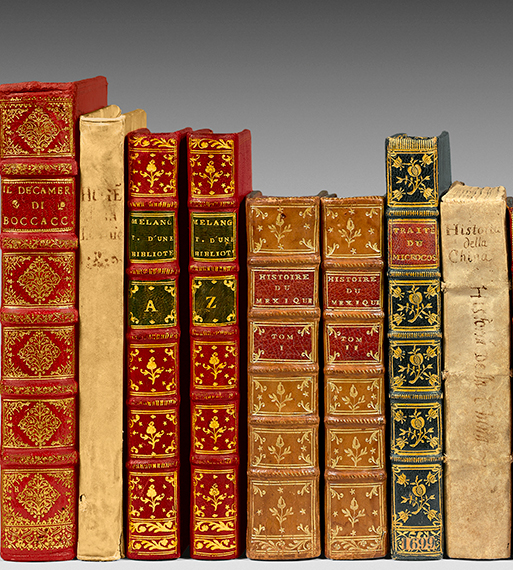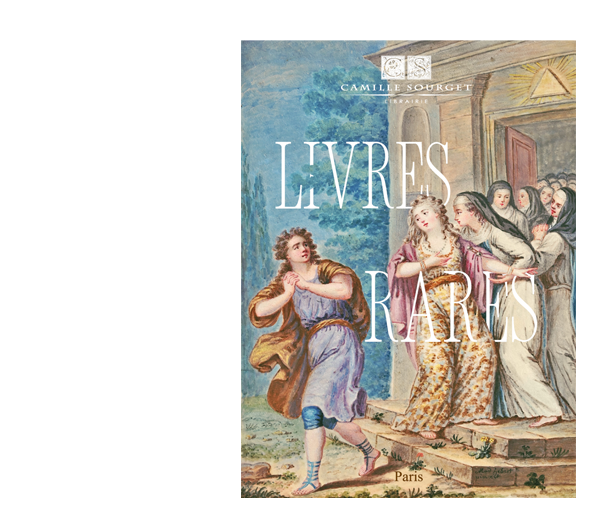Original edition printed on large vellum paper
bound at the time for Prince Cambacérès Arch-Chancellor of the Empire.
Precious copy from the libraries of Cambacérès,
Jean Lhomer et Dr. Lucien-Graux.
Paris, 1807.
Grasset de Saint-Sauveur. Journey to the Balearic Islands and Pithyuses ; made in the years 1801, 1802, 1803, 1804 and 1805, by Mr. André Grasset de Saint-Sauveur, young, Commissioner of France’s commercial relations and Consul of H.M.J. and R. to the Balearic Islands. With plates.
Paris, Léopold Collin, 1807.
In-8 of (4) ff., xvi pp., 390 pp., 2 folding plates (View of the city of Palma, Druid altar) and 1 full-page plate (Women of the Balearic Islands).
Maroon cardboard binding, boards decorated with a gilt roulette, “A. S.A.S. Monseigneur le Prince Cambacérès Archi Chancelier de l’Empire” stamped in gold letters on the upper board, untrimmed, split hinges. Binding of the era.
217 x 135 mm.
Original edition dedicated to Prince Talleyrand adorned with 3 engraved plates including 2 folding: view of Palma, costume of the women of the Balearic Islands, Druid altar.
“I have endeavored to acquire a new title to public favor through consistent research on the topography, physical wealth of the Balearic Islands and Pithyuses, and on the character, customs, industry, and commerce of their inhabitants.
I have sought to provide the most accurate and detailed description possible of the coasts and the interior of these islands.
After providing, in separate chapters, a detailed description of each of the islands, I have gathered in general chapters everything related to the character, customs, practices, industry, commerce, costumes, and language of the inhabitants of all these islands. I have dedicated a chapter to the antiquities found there, or still existing. I finally conclude with a historical overview.”
“To provide a complete picture of these islands, it was necessary not only to have traveled and resided there for several years, but also to have been vested with a character that authorized the author to gather all possible information on the country and its inhabitants; it was necessary to possess the spirit of observation appropriate to make use of these documents. Mr. Grasset de Saint-Sauveur combined these advantages, and we owe these laborious researches on the Balearic and Pithyus Islands, insights as extensive as those he provided us on the Venetian islands.
His work is divided into nineteen chapters: it contains I) The situation of the Balearic and Pithyus Islands, the origin of their names, their size, their shape; the situation, the coasts and moorings of the island of Majorca and Cabrera, 2) The description of the island of Majorca, which includes the depiction of its climate, the qualities, the cultivation and products of its lands, 3) The description of the city of Palma, 4) The situation, extent, coasts and moorings of the island of Minorca, 5) The description of the city of Mahon and its territory, 6) Observations on the climate, qualities and products of the lands and coasts of the island of Minorca, 7) The situation, extent, coasts and moorings of the islands of Minorca, 8) A particular description of the island of Formentera, and the canals formed between the Pithyus Islands, 9) The picture of the character and customs, industry and commerce of the inhabitants of the Balearic and Pithyus Islands, 10) Research on their idiom and costume, 11) The antiquities of the Balearic Islands, 12) Finally, a historical overview of the Balearic and Pithyus Islands.
Throughout the course of the work, curious and informative research, useful or piquant remarks, happy comparisons, make one forget the aridity of some topographical details…” (General Journal of French Literature, vol. 9).
Precious copy bound for Cambacérès, printed on large vellum paper.
Jean-Jacques-Régis Cambacérès, eldest son of Jean-Antoine, advisor to the Court of Auditors and mayor of Montpellier, and Marie-Rose Vassal, born in this city on October 18, 1752, became a counselor at the same Court on November 16, 1774, then a counselor to the Parliament of Toulouse in 1783; favorable to revolutionary principles, although of noble origin, he was appointed president of the criminal court of Hérault, then was elected in September 1792 deputy to the Convention, where he mainly dealt with legal issues; he became its president on October 7, 1794; he also chaired the Council of the Five Hundred from October 22, 1796, to May 20, 1797, and was appointed Minister of Justice in August 1799. Although not part of the coup d’état of 18 Brumaire, he was chosen by Bonaparte as the second consul on December 13, 1799. Having become emperor, Napoleon appointed Cambacérès Arch-Chancellor in 1804, perpetual president of the Senate, civil officer of the imperial household, member of the private council, president of the High Court, member of the Institute, where he had already entered in 1796, grand-eagle of the Legion of Honor in 1805, grand commander of the Iron Crown and Duke of Parma, Prince of the Empire, on April 24, 1808. A remarkable administrator, moderate in spirit, with sound judgment, Cambacérès, whose Civil Code and Code of Procedure were largely his work, reorganized the judicial administration and directed the internal organization throughout the Empire. After living in retirement during the first Restoration, he resumed his functions as Arch-Chancellor with the interim of the Ministry of Justice during the Hundred Days and presided over the Chamber of Peers of which he had been created a member.
However, he renounced his title of Duke of Parma on March 26, 1815. Exiled during the second Restoration as a regicide, which was not accurate, he resided in Brussels and Amsterdam, but he was allowed to return to France by royal ordinance on May 23, 1818. Returning to Paris, he lived again in retirement and died of apoplexy in this city on March 8, 1824.
Cambacérès owned a very beautiful library, mainly composed of works of law and science bound in green or red morocco.
All the books of the Arch-Chancellor were marked either with his cypher or with his arms; some had been bound for his personal account, others had been offered to him sumptuously presented.
Provenance: Cambacérès, Jean Lhomer, Dr. Lucien–Graux.

